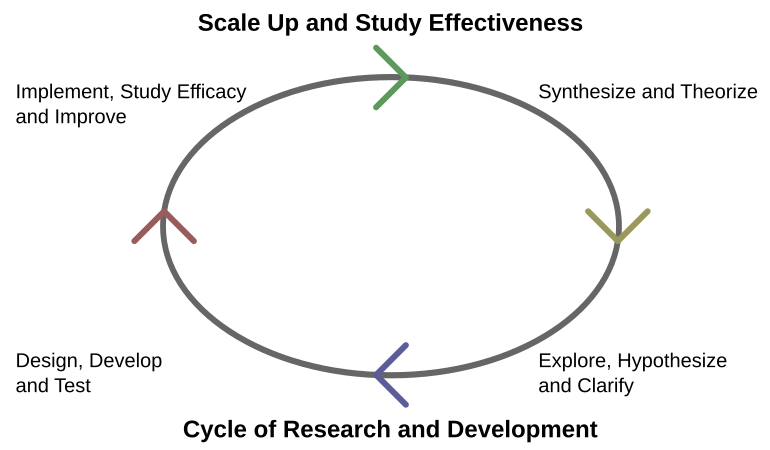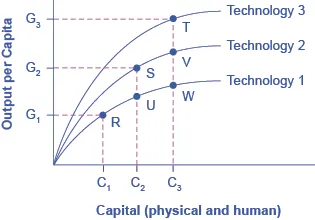AQA Specification focus:
‘Dynamic efficiency is influenced by, for example, research and development, investment in human and non-human capital and technological change.’
Introduction
Dynamic efficiency is a crucial concept in A-Level Economics, showing how firms improve productivity and innovation over time through investment, innovation, and technological progress.
Understanding Dynamic Efficiency
Dynamic efficiency refers to the ability of an economy or a firm to improve efficiency over time. Unlike static efficiency, which considers the efficient use of resources at a single point in time, dynamic efficiency focuses on how resources are allocated and used to promote innovation, adaptability, and long-term growth. It is especially important in competitive markets, where firms must invest continually to survive and grow.
Dynamic Efficiency: The improvement in economic efficiency over time, achieved through innovation, technological progress, and investment in new processes, skills, or products.
Dynamic efficiency is concerned not just with lowering current costs, but also with enhancing future capabilities.
Drivers of Dynamic Efficiency
The AQA specification identifies three major influences: research and development (R&D), investment in human and non-human capital, and technological change. Each plays a different role in shaping firm behaviour and market performance.
Research and Development (R&D)
R&D is the systematic process by which firms create new products, improve processes, and gain a competitive advantage.

A labelled diagram of the R&D cycle showing the iterative process of exploration, design, implementation, and scaling. It highlights how innovation is continuous and cyclical. Source
New products: R&D allows firms to diversify their output, creating goods that better meet consumer demand.
Process innovation: Enhancing production methods reduces costs and increases efficiency.
Competitive advantage: Firms with strong R&D can sustain market power by staying ahead of rivals.
Research and Development (R&D): Business activities directed towards innovation, creation of new products, or improvement of existing processes.
R&D typically requires large upfront costs and is risky, but successful investment can lead to high returns.
Investment in Human Capital
Human capital refers to the skills, knowledge, and experience possessed by workers. Investment in human capital is a key driver of dynamic efficiency.
Education and training: Improves workforce skills, boosting productivity and adaptability.
On-the-job learning: Allows workers to implement new technologies more effectively.
Innovation culture: Skilled workers are more capable of contributing to innovative ideas.
Human Capital: The economic value of an individual’s skills, knowledge, and abilities that contribute to productivity.
High levels of human capital enable firms to adopt cutting-edge technologies and respond flexibly to changes in demand.
Investment in Non-Human Capital
Non-human capital refers to physical and financial assets that support production and innovation.
Machinery and equipment: Modern technology reduces unit costs and improves output quality.
Infrastructure investment: Enhances production capacity and efficiency.
Financial capital: Access to funds allows firms to sustain long-term investment projects.
Such investments allow firms to build strong productive capacity and stay competitive over time.
Technological Change
Technological progress is perhaps the most visible driver of dynamic efficiency.
Process innovation: Automation, artificial intelligence, and robotics reduce costs and increase output.
Product innovation: New products satisfy evolving consumer preferences, expanding market demand.
Diffusion of technology: Widespread adoption ensures productivity gains across industries.
Technological Change: The process by which new technologies are developed, adopted, and used to improve production and products.
Technological change increases productive efficiency and supports long-term economic growth, often creating entirely new industries.

A diffusion of innovations diagram showing adoption rates (bell curve) and cumulative adoption (S-curve). It demonstrates how technology spreads from innovators to mass users over time. Source
The Interplay Between Drivers
Dynamic efficiency depends on the interaction of all three drivers. For example:

A production function diagram showing how investment in physical and human capital shifts output upward when combined with new technology. It illustrates synergy between capital and innovation. Source
R&D often requires skilled workers (human capital) to implement findings.
Human capital enables firms to adopt new technologies effectively.
Non-human capital investment provides the physical tools needed for technological progress.
Together, these drivers generate a cycle of innovation, productivity improvement, and competitive advantage.
Barriers to Dynamic Efficiency
While these drivers are powerful, achieving dynamic efficiency is not guaranteed. Common barriers include:
High costs and risks of R&D projects.
Market failures, such as underinvestment in training due to labour mobility.
Financial constraints limiting access to capital.
Regulatory restrictions that reduce incentives to innovate.
Market Structure and Dynamic Efficiency
Different market structures have varying impacts on dynamic efficiency:
Perfect competition: Low profits limit R&D investment but competition encourages innovation in cost reduction.
Monopoly and oligopoly: Higher profits can fund R&D, but lack of competition may reduce incentives to innovate.
Contestable markets: The threat of entry forces firms to innovate and invest in efficiency improvements.
This shows that both incentives and resources matter for achieving dynamic efficiency.
Long-Term Benefits of Dynamic Efficiency
Firms and economies that successfully achieve dynamic efficiency benefit from:
Lower costs and higher productivity.
Greater product variety and quality for consumers.
Sustained economic growth through technological progress.
Increased global competitiveness.
Ultimately, dynamic efficiency ensures that firms and economies remain adaptable and capable of meeting future challenges.
FAQ
Static efficiency measures how well resources are used at a single point in time, such as minimising costs or setting prices equal to marginal cost.
Dynamic efficiency instead focuses on whether firms are making long-term improvements through innovation and investment. For example, a firm may accept short-term costs from R&D in order to achieve higher productivity later.
Dynamic efficiency supports growth because innovations raise productivity across the economy.
New technologies create entirely new industries.
Human capital investment equips workers to use advanced tools effectively.
Capital deepening ensures that output continues to expand without exhausting resources.
Together, these effects sustain higher output and living standards over time.
High barriers to entry, such as patents or large start-up costs, can have two opposing effects.
They may reduce competitive pressure, lowering firms’ incentives to innovate. However, they can also give firms security to recover R&D expenses, encouraging risk-taking and investment.
Governments can encourage dynamic efficiency by:
Funding R&D programmes and universities.
Offering tax incentives for innovation.
Regulating competition to prevent firms from abusing monopoly power.
Supporting education and vocational training to improve human capital.
Well-designed policies reduce risks for firms while promoting innovation.
Smaller firms often face limited financial resources, making it harder to fund costly R&D projects or purchase advanced equipment.
They may also find it difficult to attract highly skilled workers without offering competitive wages. Larger firms, by contrast, can spread risk across projects and use economies of scale to invest more consistently in innovation.
Practice Questions
Define dynamic efficiency. (2 marks)
1 mark for recognising that dynamic efficiency relates to efficiency over time.
1 mark for mentioning that it arises from innovation, technological progress, or investment that improves future productivity.
Explain how investment in human capital and technological change can act as drivers of dynamic efficiency in firms. (6 marks)
1 mark for explaining that human capital refers to the skills, knowledge, and abilities of workers.
1 mark for noting that investment in human capital (e.g. training, education) increases productivity or adaptability.
1 mark for identifying technological change as the development and adoption of new technologies.
1 mark for showing that technological change can reduce costs or improve products, supporting long-term growth.
1 mark for linking both human capital and technology to improved efficiency over time.
1 mark for a clear example or application (e.g. training workers to operate new machinery).

